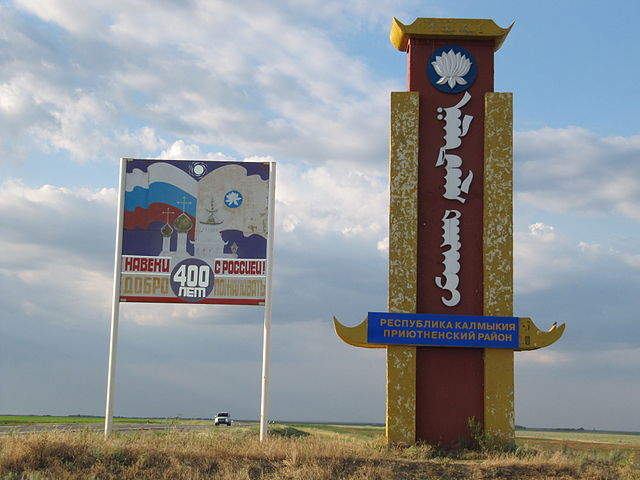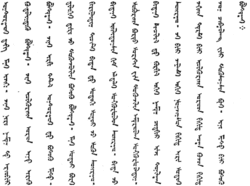Top Qs
Timeline
Chat
Perspective
Clear Script
Writing system for the Oirat language From Wikipedia, the free encyclopedia
Remove ads
The Clear Script[note 1] is an alphabet created in 1648 by the Oirat Lamaist monk Zaya Pandita for the Oirat language.[1][2][3] It was developed on the basis of the Mongolian script with the goal of distinguishing all sounds in the spoken language, and to make it easier to transcribe Sanskrit and the Tibetic languages.

Remove ads
History
The Clear Script is a Mongolian script, whose obvious closest forebear is vertical Mongolian. This Mongolian script was derived from the Uyghur alphabet. The Clear Script was developed as a better way to write Mongolian, specifically of the Western Mongolian groups of the Oirats and Kalmyks.[3]: 548 It resolved ambiguities in the written language by assigning symbols to vowels, and adding new symbols and diacritics to show vowels and vowel lengths, and to distinguish between voiced and unvoiced consonants.[3]: 548 [2]: 145 Symbols that were preserved from the traditional Mongolian script were assigned a fixed meaning.[2]: 145
There were even some marks enabling distinctions that were unimportant for words written in the Oirat language but were useful for the transcription of foreign words and names, such as between ši and si.[2]
Remove ads
Usage
The Clear Script was used by Oirat and neighboring Mongols, mostly in the late 17th and early 18th centuries.[2] It was widely used by its creator and others to translate Buddhist works so that they might better spread the Buddhist religion throughout western Mongolia. Though the script was useful for translating works from other languages, especially Tibetan, it was also used more informally, as evidenced by some letters from the late 1690s.[2]
Around the 19th and early 20th centuries, some Altaians in Russia were able to utilize the script to read and write texts due to contacts with Mongolian Buddhists.[4]
The script was used by Kalmyks in Russia until 1924, when it was replaced by the Cyrillic script. In Xinjiang, Oirats still use it, although today Mongolian education takes place in Chakhar Mongolian all across China.
Remove ads
Writing in the Clear Script
This script is a vertical script, as was its 'vertical Mongolian' parent script. Letters and diacritics are written along a central axis. Portions of letters to the right of the axis generally slant up, and portions to the left of the axis generally slant down. The only signs that do not follow these rules are the horizontal signs for S, Š, and part of Ö.[2] Words are delineated by a space, as well as different letter forms. Though most letters only come in one shape, there are some letters that look different depending on where in the word they occur, whether they are initial, medial, or final.[3]
Tables
Summarize
Perspective
There is an alphabetic order in the Clear Script, as in other related scripts, but the order for it is not the same as its Mongolian parent script. The Clear Script order is: a, e, i, o, u, ö, ü; n, b, x, ɣ, g, k & k’, q, m, l, r, d, t, y, z/ǰ, c/č, s, š, ng, v/w.[2]: 150–151
Vowels
Consonants
Ligatures
Remove ads
See also
Wikimedia Commons has media related to Todo bichig.
Notes
- Oirat: ᡐᡆᡑᡆ
ᡋᡅᡒᡅᡎ / Тодо бичиг, romanized: todo bičiq / todo bičig, [todo bit͡ʃ(ə)k] - Mongolian: Тод бичиг / ᠲᠣᠳᠣ
ᠪᠢᠴᠢᠭ, romanized: tod bichig / todo bičig, [tɔd bit͡ʃək] - Russian Buryat: Тодо бэшэг, romanized: Todo besheg, [tɔdɔ bɛʃək]
- Oirat: ᡐᡆᡑᡆ
- Modern Kalmyk Oirat (Cyrillic) equivalent (?)
- GOST 7.79-2000 (ISO 9:1995)[8]: 9, 16
- Daniels
- Should appear without a final left-pointing tail.
- Should appear with an intervocalic tooth.
- Should appear with an intervocalic tooth.
- Should appear without a final left-pointing tail.
- Should appear without a final left-pointing tail.
- Confer Kalmyk Oirat хар har; Hudum ᠬᠠᠷᠠ qar‑a; Khalkha хар khar.
- Confer Kalmyk Oirat һал ḥal; Hudum ᠭᠠᠯ ɣal; Khalkha гал gal.
- Confer Kalmyk Oirat гер ger; Hudum ᠭᠡᠷ ger; Khalkha гэр ger.
- Confer Kalmyk Oirat көк kök; Hudum ᠬᠥᠬᠡ köke; Khalkha хөх khökh.
- Confer Kalmyk Oirat цаг cag; Hudum ᠴᠠᠭ čaɣ; Khalkha цаг tsag.
- Confer Kalmyk Oirat зун zun; Hudum ᠵᠤᠨ ǰun; Khalkha зун zun.
- Confer Kalmyk Oirat җил z̦̆il; Hudum ᠵᠢᠯ ǰil; Khalkha жил jil.
- Confer Kalmyk Oirat цә ca̋; Hudum ᠴᠠᠢ čai; Khalkha цай tsai.
- Confer Kalmyk Oirat чи či; Hudum ᠴᠢ či; Khalkha чи chi.
- Should appear as a bow with a down-pointing tooth, followed by a round ü.
- Should appear in line with be and ke.
- Should appear in line with bi and ki.
Remove ads
References
External links
Wikiwand - on
Seamless Wikipedia browsing. On steroids.
Remove ads

